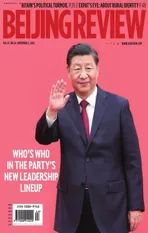BEHIND THE SCENES
2022-11-04The20thCPCNationalCongressthroughtheeyesofreporterByYuanYuan
The 20th CPC National Congress through the eyes of a reporter By Yuan Yuan
The second floor of the Great Hall of the People in Beijing has not seen this many journalists since COVID-19 hit China.
It was the place where approximately 2,500 registered journalists, including over 700 from overseas, covered the opening and closing ceremonies,respectively on October 16 and 22, of the 20th National Congress of the Communist Party of China(CPC).
The building, located on the western side of Tiananmen Square, is where the country’s major political events take place.Its second floor is the area for journalists when events, such as the annual sessions of the National People’s Congress and the Chinese People’s Political Consultative Conference National Committee, also known as the Two Sessions, are convened.
However, beginning in 2020,COVID-19 prevention and control measures limited the number of journalists allowed to attend events inside the hall, with most only able to follow the opening and closing ceremonies of the Two Sessions remotely on screen.
Press center
To ensure journalists were able to safely cover the congress amid the ongoing sporadic spread of COVID-19 in China was no easy job.
Journalists were requested to arrive at the designated hotels two days prior to the ceremonies and undergo daily nucleic acid tests. The two designated hotels most journalists stayed at are very close to each other. The press center of the congress was set up inside one of the hotels, Hotel Nikko New Century Beijing. At each hotel, shuttle buses departed every 15 minutes to commute between the two, and journalists could choose to have buffet meals at either hotel.
It reminded Björn Kurtenbach from ARD German Television of the closed loop management of the Beijing 2022 Olympic Winter Games. “I didn’t go into the closed loop at the Beijing Winter Olympics, but I saw videos made by my coworkers inside the loop and it looked similar.”
For him, the fact journalists could meet up at the canteen and have meals together was a bonus within the closed loop. The press center became the public space where many journalists would spend time. Gadgets used for shooting videos with smartphones and reporters dressed up and illuminated by camera lights became a common sight. The tea break area, serving snacks, coffee and fruit, was always packed with chatting journalists.
The closed loop management made the reporting experience at this congress a different one.Before COVID-19 hit, journalists with press passes had access to the hotels housing delegates and could also stop the delegates for interviews before and after the assemblies at the Great Hall of the People.
This year, face-to-face interviews were not arranged so interviews were instead conducted remotely. Within each delegate’s team, a contact person was responsible for receiving media enquiries. One of the delegates’ duties, apart from the regular congress schedule, was to accept audio and video interviews. Several rooms at the press center were specifically set up for conducting video interviews, featuring equipment to record high-definition videos.
The delegates’ schedules were intense. When I interviewed a delegate from Ningxia Hui Autonomous Region via phone,it was almost 10 p.m. She had just finished a whole day of meetings and returned from visiting an exhibition. Before taking my interview, she had just postponed another interview to the next day.“It’s been a long day,” she said.“But don’t worry, I am ready to answer all your questions.” The interview lasted over 50 minutes.
For foreign journalists who couldn’t speak Chinese, the organizer arranged group interviews and offered interpretation services.
Group interviews
Even at the press center, the schedule was intense as there were five press conferences and five group interviews during this seven-day congress. The five press conferences were broadcast live,whereas the group interviews, one of the highlights of the congress,were not.
Thirty-four spokespersons from delegates’ teams joined the group interviews from October 18 to 20. These spokespersons were mostly top officials from provinces, municipalities and autonomous regions. It was the first time ever for the CPC National Congress to arrange this many interviews.

Journalists attend a group interview hosted by the press center of the 20th Communist Party of China National Congress via video link in Beijing on October 19
During each group interview,several speakers spoke on behalf of the delegation they each represented. Each speaker first introduced their team and the opinions of its delegates on the reports to the congress and then took questions from journalists.
This was not common practice for these speakers. Some had prepared their notes in advance.Some looked very nervous and some were relaxed. The questions from journalists covered hot topics including the construction of Xiongan New Area,common prosperity and highquality development.
Each spokesperson received questions during the interviews. Some spokespersons made use of words or phenomena trending online while answering questions. Lian Yimin, Deputy Secretary of the CPC Hebei Provincial Committee, mentioned Baer’s pochard, a critically endangered species of diving duck that has been spotted in the wetland of Baiyangdian Lake at Xiongan New Area since last year, to give an example of how Xiongan’s ecological environment had improved. “The duck has become an online celebrity,” he said.
Some officials became stars for their eloquence at the group interviews. Wang Gang, head of the Publicity Department of the CPC Zhejiang Provincial Committee, elaborated on the challenges that Zhejiang, China’s pilot province in pursuing common prosperity, has encountered.The clip of him speaking was uploaded to major short video platforms and hailed by many netizens as an example of “officials with fluent and down-to-earth words.”
“It is a positive signal that more channels will open for communication between officials and the public,” said Yang Yujun, a professor at the Communication University of China. BR
